|
Fisher
Body - Home
Fisher Body Craftsmanship Goes to War
Fisher Body - Craftsmanship
Fisher Body - Aircraft
Fisher Body - Aircraft
Instruments
Fisher Body - Guns
Fisher Body - Tanks
Fisher Body - Miscellaneous
The Plants
Fisher Body WWII Plant Database
Cleveland Plant #1, OH Plant
Cleveland Plant #2, OH Plant
Detroit Aircraft Unit,
Detroit, MI
Detroit Die and Machine Plant
Fleetwood, Detroit, MI Plant
Flint Plant #1, MI Plant
Grand Blanc, MI Tank Arsenal
Grand Rapids, MI Plant
Lansing, MI Plant
Memphis, TN Plant
Ternstedt Manufacturing Division,
Detroit, MI
Grand Blanc Tank Arsenal Built Tanks and Tank Destroyers
Grand Blanc
built M4A2 Sherman Tank Photos
Grand Blanc
Built M4A3 Tank Photos
Grand
Blanc M10 Tank Destroyer Photos
The Fisher Body Grand Blanc, MI Tank Arsenal in World War Two
A Surviving Fisher
Body Plant
1942-Current
Fisher Body - Gone but not Forgotten!!!
This page updated 11-7-2019.
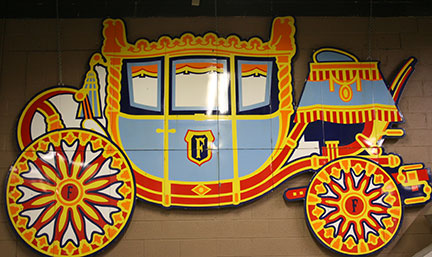
"I don't get no respect!" - Rodney
Dangerfield 1921-2004
Abstract:
The Fisher Body Tank Arsenal in Grand Blanc, MI never got the publicity
and hype of the Chrysler Tank Arsenal either during or since WWII.
Grand Blanc never received the credit it deserved for delivering
desperately needed tanks and tank destroyers with more potent main guns
or heavier armor to soldiers facing better German tanks in Europe after
the Normandy invasion. However, the US Army recognized its
importance by awarding Fisher Body Grand Blanc the Army-Navy "E" Award
five times.
Below is the complete story of the importance of Grand Blanc Tank Arsenal in WWII,
which until now went unrecognized.
David D Jackson 12-4-2015
Ground was broken for the 452,000 square
foot Fisher Body Tank Arsenal in Grand Blanc, MI in January 1942; and
M4A2 Sherman tanks started coming off its assembly line in July.
Prototype work was done and all of the necessary tooling, fixtures and
jigs at Fisher Body #1 4.5miles north on Saginaw Street.
The first tank came off the prototype line April along with three others
and in May sixteen more M4A2s came off the Flint 1 prototype
line, allowing Fisher Body to deliver tanks two months before scheduled,
and before the Grand Blanc plant was finished in July.
Grand Blanc produced 19,034 tanks, tank
destroyers and prime movers from April 1942 to October 1945. This
record makes it second in the production of tanks and tank destroyers
during World War Two. The plant was built and owned by the US
government with Fisher Body operating it during the war years. In
1946 Buick leased the facility for storage, and then purchased it in late
1950. On June 1,1951 Fisher Body Division took possession of the
facility in order to build 4,200 M48 Patton tanks for the Korean War
effort. Construction began on additions to the plant, resulting in a total of 1,179,442 square feet. When M48 production
ceased in 1955 Fisher Body converted it into a metal stamping plant, operating it
until it disappeared as a division in 1986. Several different GM
divisions then controlled it until the Metal Fabrication Division that
took possession of the plant in 1994. In 2002 the presses were
moved out; and the facility became the GM Tool Weld Tool Center until
closing on July 1, 2013. When it closed, the plant had grown to 1.6 million square
feet on 311 acres of land.
When I was there in June 2015, GM was
using the parking lot of the plant for car storage. The plant is
on the list of plants to be razed. With all of the commercial growth
in the area, the land will quickly be redeveloped into shopping centers,
housing, or new smaller factories. So while the factory that did
so much to help win WWII will soon disappear and be forgotten, this
webpage will keep its important contributions alive.
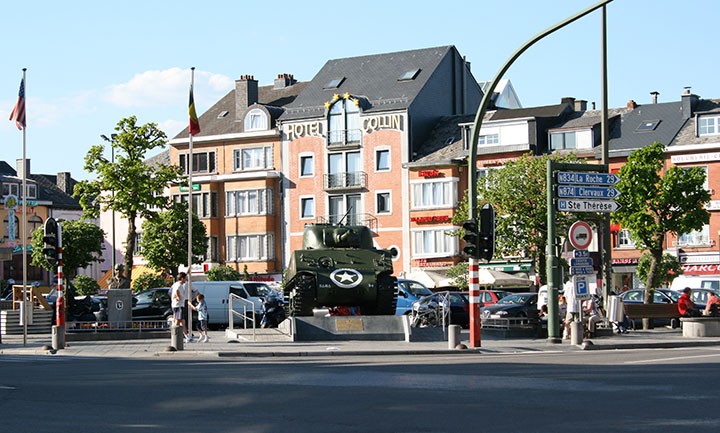
There were 49,234 M4 Sherman tanks of various types built by ten companies
during the Second World War. This Fisher Body built M4A3 Sherman tank combat veteran is displayed
in downtown Bastogne, Belgium. It was knocked out of combat during one of the most famous
battles of World War Two, the Battle of the Bulge, in December 1944.
It now sits at the intersection of several roads in Bastogne, the
location that made the
town an important military objective during the battle. Author's
photo.
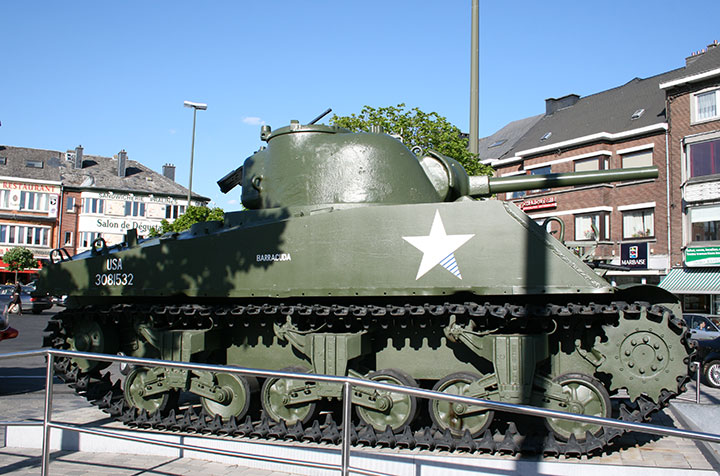
Of all of the Sherman Tanks built during WWII it is
noteworthy that one built by Fisher Body in Grand Blanc, MI in March of
1944 has the honor of representing all of the M4s that participated in
the Battle of the Bulge. Registration Number 3081532 was one
of 339 M4A3 Sherman tanks built in the Fisher Body Tank Arsenal in Grand
Blanc, MI in March 1944. Author's photo.
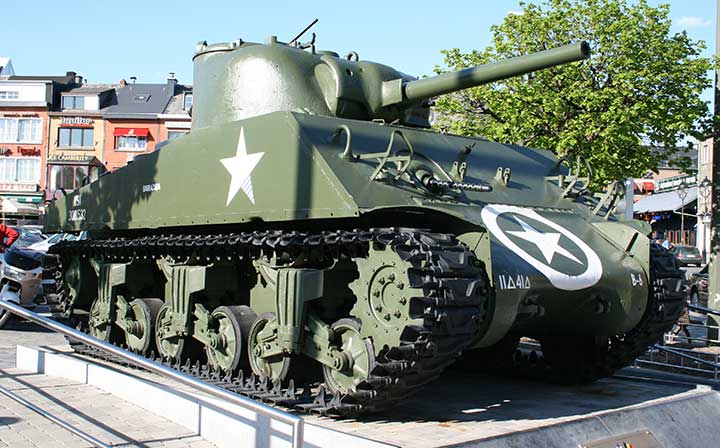
The M4A3 Sherman tank was powered by a Ford
V-8 engine and armed with a 75mm cannon. This particular M4A3 was one of 1,711 M4A3s
that were built by Fisher Body between February and September 1944.
Author's photo.
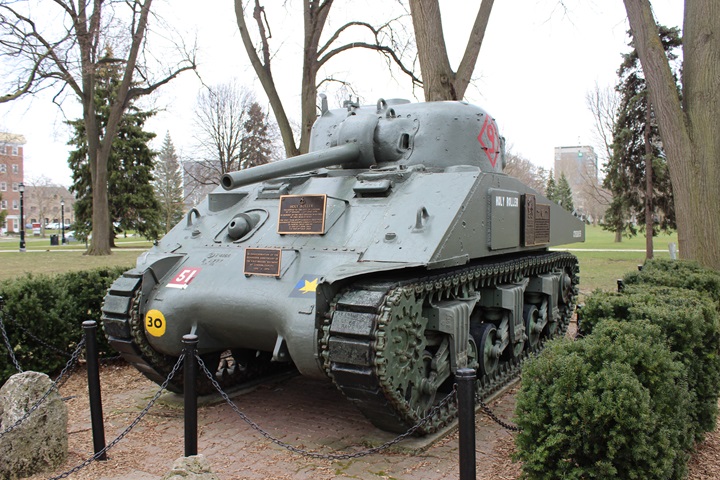
This M4A2 is the oldest Fisher Body built
tank in North America, and is on display at Victoria Park in London,
Ontario. It came off the Grand Blanc assembly line in September
1942. It landed with the Canadian Army at Normandy, and then
fought its way across Europe until the end of the war. It survived
the many battles it was in, and then came back to Canada. Author's
Photo.
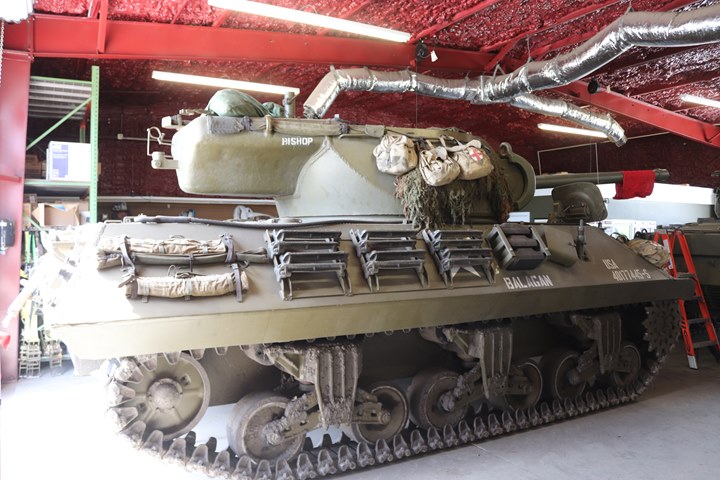
Fisher Body built M36 Serial Number 115.
This is one of 300 Grand Blanc M10A1s that were pulled off the line with
no turrets. The workers at Grand Blanc then rebuilt the inside of
the vehicles to store 90mm rather than 3 inch ammunition. Newly
fabricated turrets with the 90mm main guns were then installed.
Nine survive worldwide and three in the United States. This one is
owned and operated by WW2 Armor in Orsteen, FL. Author's photo
added 3-28-2019.
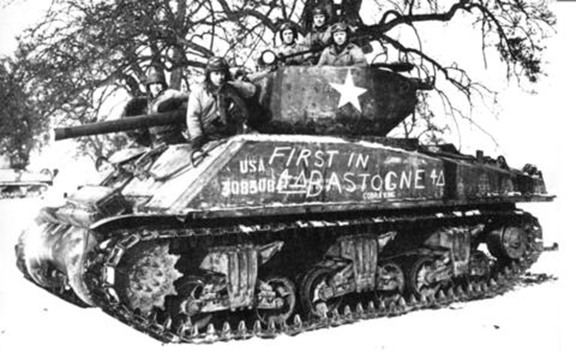
The first tank into Bastogne, Belgium with
Patton's Third Army was this Grand Blanc-built M4A3E2 "Jumbo." It
was named Cobra King and still exists today. It has already been
placed on location at the new National Museum of the US Army that will
open at Fort Belvoir, VA in late 2019.
The Fisher Body Grand Blanc Tank Arsenal was
awarded the Army-Navy "E" Award five times.

The Fisher Body Grand Blanc Tank Arsenal was awarded the Army-Navy "E" Award
on January 15,1943.
The plant was awarded its first star on September 22,1943. This
was for the timely production of M4 Sherman tanks and M10 Wolverine tank
destroyers
It received its second star on July 30,1944.
The third star was awarded March 5,1945.
The fourth star was awarded May 17, 1945.
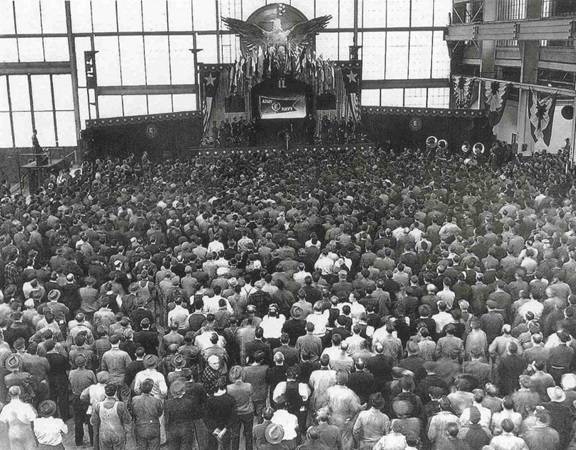
This photo shows the awarding of the
Army-Navy "E" award on January 15,1943. The award ceremony always
included the workers being present, even though this shut down needed
war production, as the military officials wanted the workers to know how
important they were to winning the war. This type of ceremony
happened 4,283 times during the war. Photo added 12-16-2016.
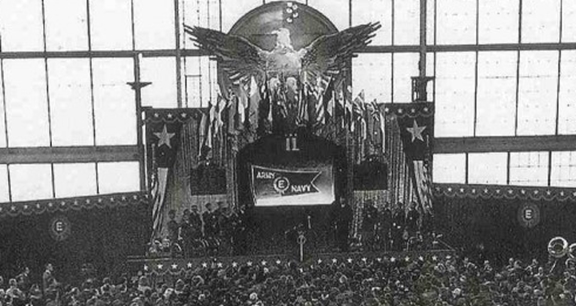
Hanging center stage is the Grand
Blanc Tank Arsenal "E" flag. Today its location, if it still
exists, is unknown. Photo added 12-16-2016.
Unfortunately the Fisher Tank Arsenal did
not get the publicity given to the Chrysler Tank Arsenal in Warren, MI;
whether that was then or from WWII historians today. There are a
few reasons for this. Firstly, the Chrysler plant
was built and got into production a year earlier than the Fisher plant,
and when it opened, it was in April 1941, before the US was officially
at war. When the Grand Blanc plant opened, the nation was at war
and there were many new war plants opening and being converted to war
production. It did not make for the same news impact as was Chrysler's
opening the year before.
Secondly, Chrysler did an excellent job of
promoting its new plant, even producing a movie entitled "Assembly Lines
of Defense" which can be found today online. The link
to this informative video is posted on my "Links" page.
Conversely,
there was not much publicity by General Motors about its tank plant
at Grand Blanc. In 1946 Chrysler published an excellent series of
seven small books on the subject of the company's accomplishments during the Second World War. The book on the Warren
Tank Arsenal was entitled "TANKS are Mighty Fine Things" and gave the
complete history of the plant. Conversely, GM and the other auto
makers put the war behind them, addressing the challenge of getting
the auto assembly lines back going and making automobiles.
Thirdly, most history today is Detroit-centric,
focusing on the Detroit metropolitan area such as Chrysler's Warren
location. Meanwhile, places like Flint, Grand Blanc, Lansing and a multitude of other important locations
are overlooked or not given the emphasis as the Detroit area.
In spite of the lack of publicity the Fisher
Tank Arsenal did contribute significantly to the war effort. Its
contribution is outlined with the information and photos below.
Fisher produced at total of 19,052 tanks and tank destroyers, 3,183 less than the Chrysler Warren plant. If one looks at the
number of tanks produced by Chrysler in first extra year of production
it had in 1941, the numbers between the two are comparable.
M10 Series Wolverine Tank Destroyers:
Fisher Body Grand Blanc with Ford Motor Company produced all of
M10 and M10A1 Tank Destroyers. Fisher produced 4,993 M10s and 375
M10A1s, and Ford 1,038 M10A1s. The difference between the two
types were Fisher built M10s were powered by twin
6-71 Detroit Diesel engines, and the M10A1s were powered by Ford GAA
V-8 gasoline engines. Because of the larger
number built by Fisher Body and the difference in the engines, the US
Army sent the Fisher Body M10s overseas to the combat zones. The Ford
M10A1s were kept in the US for training purposes.
First combat for the M10 was March 23, 1943 in the North
African campaign at the battle of El Guettar in Tunisia. The 899th Tank Destroyer Battalion lost seven M10s, but helped
to destroy thirty German tanks. At Salerno, Italy, Sgt. Edwin Yost became
the first M10 "ace" when he destroyed five PzKpfw IV tanks on September
14, 1943.
Between June 1944 and the end of the war in
May 1945, M10 monthly strength in the European Theatre of operations varied
between 486 and 790; and 540 were lost in combat. The British
received 1,548 Fisher built M10s, the USSR was given 52 under
Lend-Lease, and the Free French Army was provided 255 M10s. The
M10 also served in the Pacific but not to the extent as in Europe
due to the lack of Japanese tanks.
The main point is that Fisher Body Grand
Blanc built all of the M10s in combat during WWII. All photos of
M10s in combat during WWII were Fisher Body built and it was the first
of three fully tracked Tank Destroyers to enter combat for the US Army.
Today there are 37 M10s and 58 British Achilles still in existence.
The British replaced the 3 inch gun in the M10 with a 17 pounder main
gun and called it the Achilles.
Until March 1, 1943 the M10 was classified
by the War Department as "Secret". From a manufacturing standpoint
the turret was constructed of armor plate instead of a cast turret like
the M4. The design using the armor plate allowed for reduced
production hours by using automatic welding machines instead of having
to be hand welded.
|
Fisher Body
M10 Wolverine in Europe 1944-1945 - Strength and Losses |
| |
Jun44 |
Jul44 |
Aug44 |
Sept44 |
Oct44 |
Nov44 |
Dec44 |
Jan45 |
Feb45 |
Mar45 |
Apr45 |
May45 |
Total |
|
Strength |
691 |
743 |
758 |
763 |
486 |
573 |
790 |
760 |
686 |
684 |
427 |
427 |
Losses |
|
Losses |
1 |
17 |
28 |
40 |
71 |
45 |
62 |
69 |
106 |
27 |
37 |
37 |
540 |
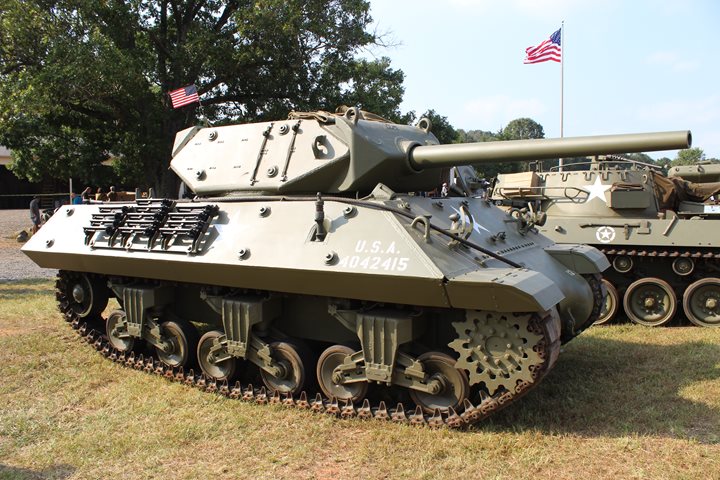
This Grand Blanc built M10 Wolverine was
totally restored in 2016 by the Virginia Museum of Military Vehicles in
Nokesville, VA. This photo was taken at its premier public showing
on September 24, 2016 at the Museum's annual open house. Author's
photo added 10-7-2016.
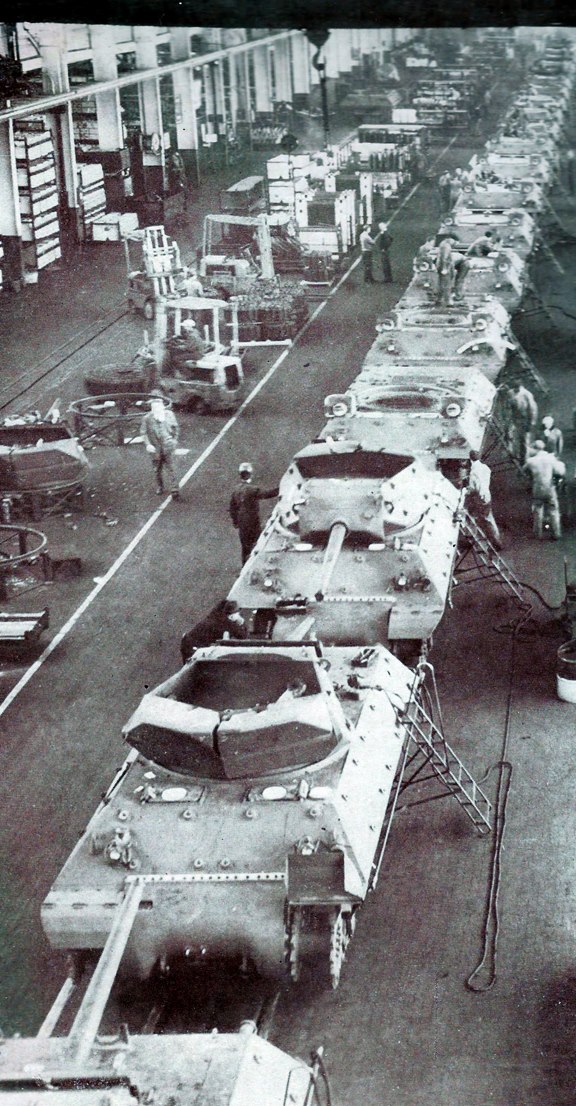
M10 Wolverine Tank Destroyers come
down the Grand Blanc assembly line. Photo added 11-18-2015.
Below are several photos of M10 tank destroyers in action in Europe.
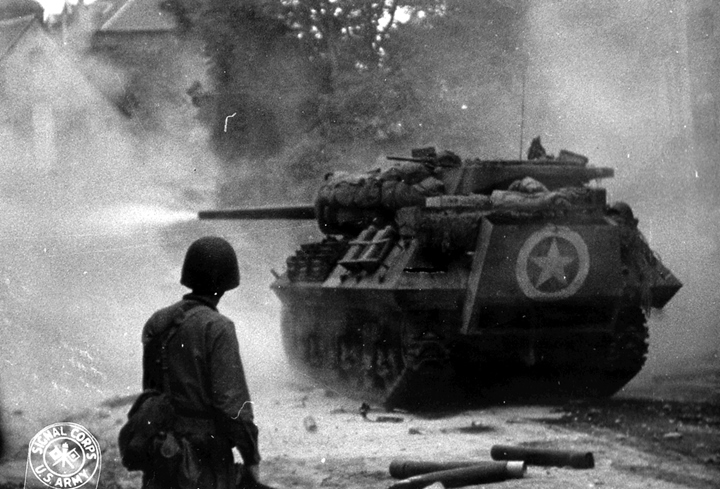
A Fisher Body M10 built in Grand Blanc, MI
fires its three inch Oldsmobile built gun at a target in Normandy,
France in July 1944. This was one of 743 deployed with US forces in Europe in July 1944.
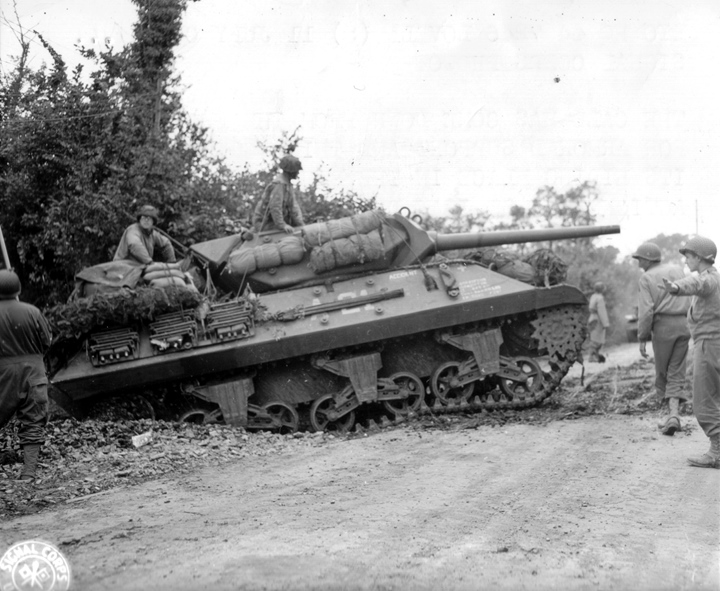
This photo provides an excellent profile
view of another Fisher Body built M10 Wolverine as it comes out of
hedgerow in Normandy. This particular vehicle belonged
to the 889th Tank Destroyer Battalion. Photo added 11-10-2015.
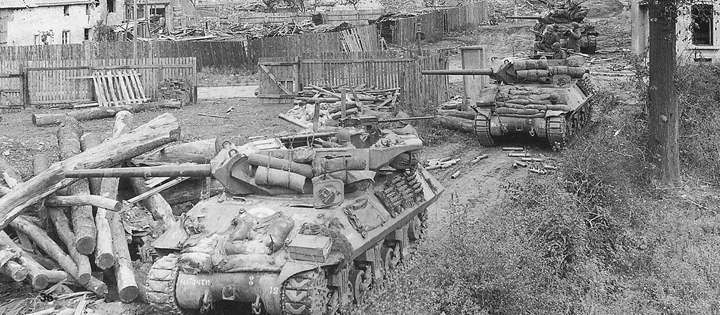
Three M10 Wolverine tank destroyers are
moving into position to fire on a German observation post in Aachen
Germany in October 1944. This was the first German city to be
captured by the US Army and the Grand Blanc M10s were there. As
can be seen in this series of photos, the M10 was used for general fire
support along with its main mission of destroying tanks. Photo
added 11-18-2015.
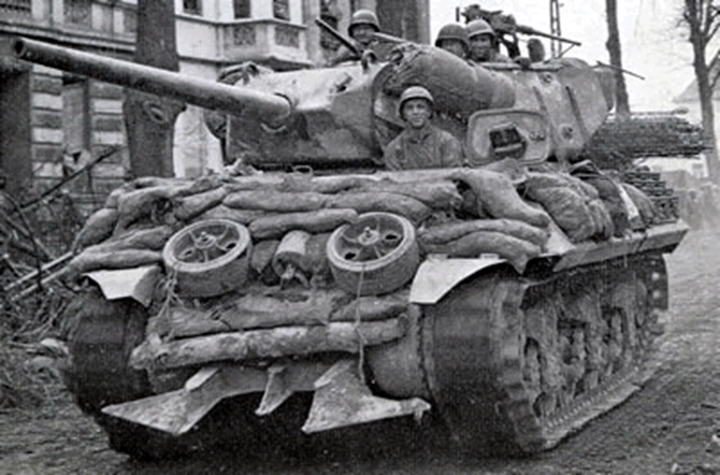
The WWII tank destroyer was designed to not
be well armored; and was to rely on speed in combat with enemy tanks.
It
fell into the category of "it sounded like a good idea of time".
There have been innumerable books and articles written about the US WWII
misguided tank and tank destroyer theory ad nauseum. Whatever the
official policy and theory, the M10 tank destroyer crews in their Grand
Blanc, MI built vehicles were in the thick of the battle, doing whatever it
took to win the war. This particular M10 has attached sandbags,
wheels, and logs to the vehicle to help defend against enemy anti-tank
projectiles. Also steel from the Normandy beach obstacles was cut up and welded to the front of the M10 to allow it to penetrate
the hedgerows of Normandy. This was known as a Culin hedgerow
cutter. Photo added 11-10-2015.
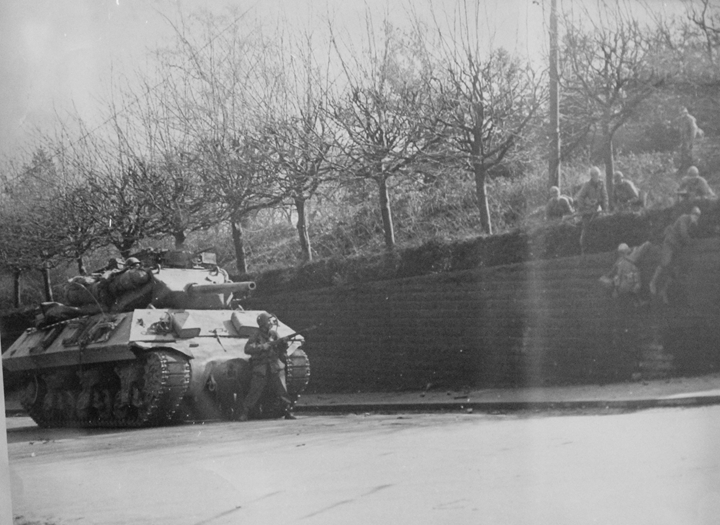
A Fisher Body built M10 assists members
of the 90th Infantry Division flush out a German soldier from a pillbox
at Mainz, Germany on March 22, 1945. Note that there is an extra
armor plate welded to the front of the vehicle. Photo added 11-9-2015.
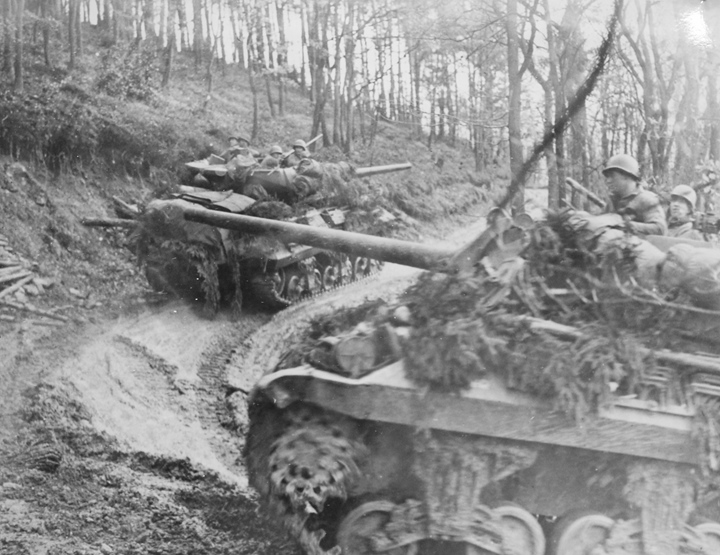
Two Grand Blanc M10 tank
destroyers are slogging through a German forest near the end of WWII.
Photo added 11-9-2015.
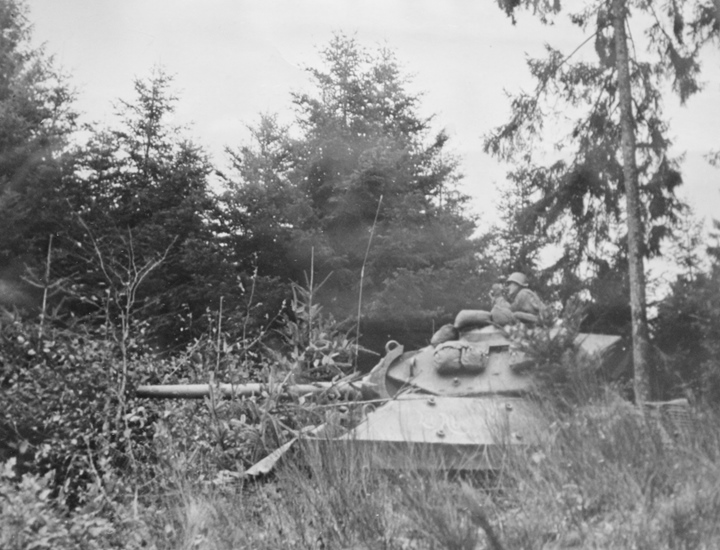
Another Fisher Body Grand Blanc built M10 in
action in Europe during WWII. Photo added 11-9-2015.
M36 Jackson Tank Destroyers:
There were three different types of M36 tank destroyers as defined
below.
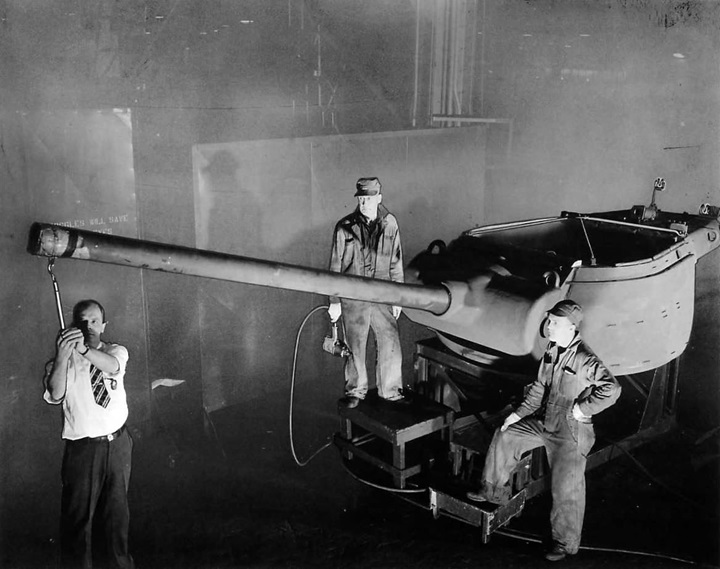
This photo from 1944 shows construction one
of 714 M36 turrets Fisher Body built at Grand Blanc. Photo added
12-16-2016.
M36: The M36 utilized the Ford
and Fisher Boyd M10A1s that had been previously built and converted them
to the M36 by installing a new larger turret with a 90mm main gun.
Also, the last three hundred Fisher built M10A1s were constructed without turrets. Grand Blanc fabricated turrets with a 90mm main
gun, and installed them in these 300 M10A1 chassis.
Because Grand Blanc was so busy with other war contracts, the
re-conditioning and addition of the new turrets for the remaining M10A1s was
contracted to other companies. Fisher Body, according to
Fisher Body Craftsmanship goes to War, supplied 713 turrets for the
M36 Jackson Tank Destroyers being converted by the other contractors.
In the end M10A1s finally saw combat as the M36.
M36B1: The M36B1 was a
pure Grand Blanc version of the M36. It consisted of a Fisher
built M4A3 Sherman tank chassis with the Fisher Body fabricated 90mm
turret installed. Only 187 of these were built, making it the
rarest of the M36 series tank destroyer. This version was
developed when the US Army couldn't retrieve all of the M10A1s fast
enough to convert them into M36s. So in the
emergency Grand Blanc built 187 M36B2s on the M4A3 chassis.
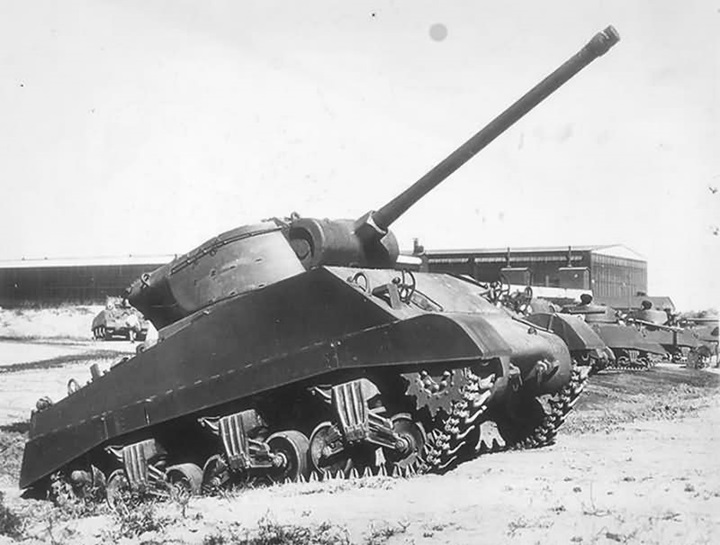
M36B1 tank destroyers sitting outside of the
Grand Blanc Tank Arsenal. Only 217 M36B1's were built and several
of them are in photo. The photo is the only known WWII photo of
the exterior of the plant. Photo added 12-17-2016.
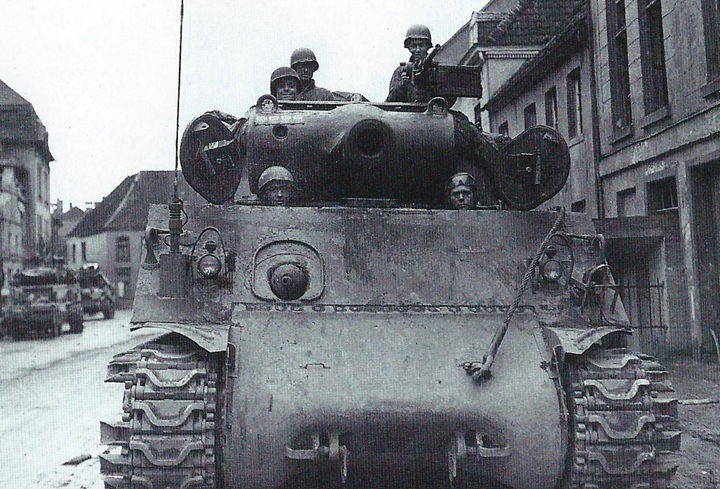
This is a rare photo of one of the 187
Fisher Body built M36B1 Jackson tank destroyers in the European combat
zone. Note on the turret are four victory markings indicating this
M36B1 has destroyed two German Tiger tanks and two Panzer IVs. The
new 90mm main gun was doing its job! This Grand Blanc built unit
is serving here with the 654th Tank Destroyer Battalion.
Photo added 11-18-2015.
M36B2: These were 724 Fisher built M10s
that were converted to the M36B2. Conversion started with 50 in
May 1945 and the remaining 674 being converted after the end of WWII.
They can be indentified by a sheet metal covering over the turret and a
large muzzle brake. The result was the
M36B2 powered by Detroit Diesel engines.
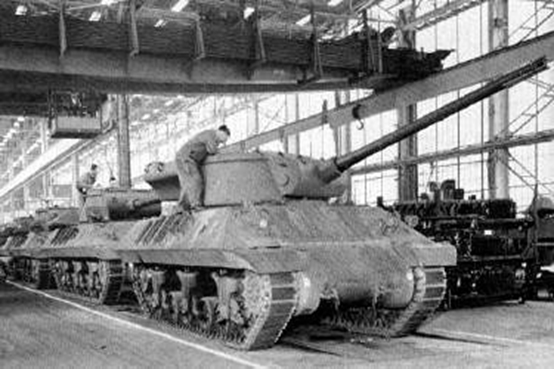
Several of the 300 M36 tank destroyers coming down the
assembly line at Grand Blanc during 1944. Photo added 12-16-2016.
Today there are 80 M36 tank destroyers still
in existence, of which seven are the M36B1 model. Most of them are overseas, as they were given to foreign
countries after WWII.
M4 Sherman Tanks: Grand Blanc
built 11,358 M4A2 and M4A3 tanks between April 1942 and May 1945,
totaling 23% of the 49,234 built by ten different companies during the
war. Grand Blanc, Chrysler, and Pressed Steel Car
Company were the only companies still producing the Sherman tanks at war's end.
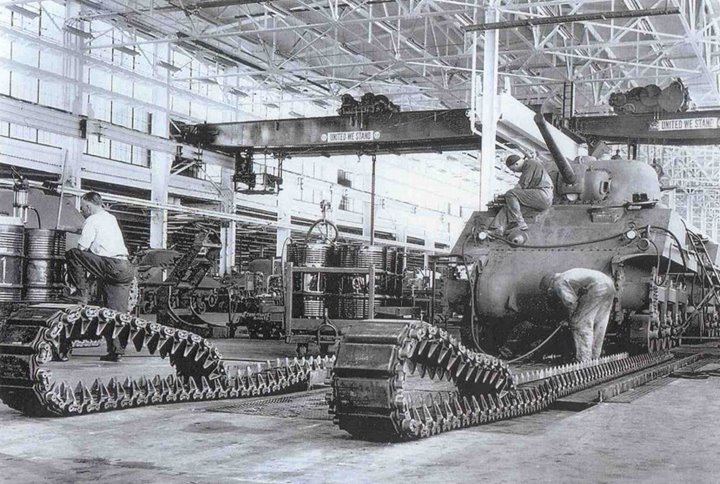
The tracks are being prepared for installation on an M4A2 small hatch
Sherman tank on the Grand Blanc assembly line. Photo added
12-16-2016.
There were four basic types of Sherman tanks
built based on the engine type. The M4/M4A1 was powered by a
Continental R-975 Radial aircraft engine and at the beginning of the war
was the preferred Sherman for the US Army. Fisher did not build
any of this type.
The second type was the M4A4 which was built
exclusively by Chrysler with its Multi-Bank engine. This model,
like the diesel powered M4A2 described below, was built because there
were not enough R-975 engines for all of the tanks that needed to be built. Both the
M4A4 and the M4A2 for the most part were given to the United Kingdom and the
Soviet Union under Lead-Lease. Fisher did not build any of the
M4A4.
The third type was the M4A2,which was built in quantity by Fisher
Grand Blanc and three other companies. It was powered by twin GM Detroit
Diesel 6-71 engines driving a single drive shaft and designated as the
6046 engine. It was only natural that Grand Blanc would build the
M4A2, as General Motors did a good job during the war of using the
products of other GM divisions in its final products. At the start
to of WWII, the automotive diesel engine was just starting to come into
its own, and was not nearly as prominent as it is today. Having
the Fisher Tank Arsenal build tanks with Detroit Diesel engines was an
excellent way to showcase the attributes of
the diesel engine for future sales after the war.
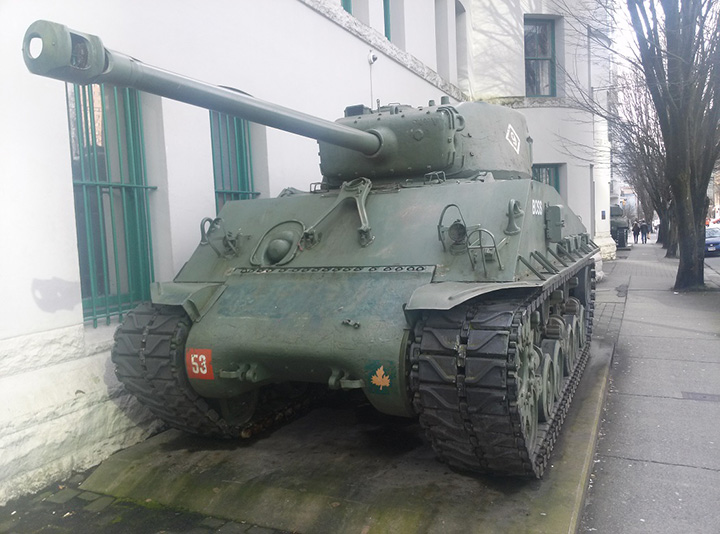
This M4A2(76)HVSS is Grand Blanc serial
number 69192 and registration number 30129671 which was built in April
1945. It can be seen outside the Beatty Street Drill Hall in
Vancouver, BC. It was one of 7,508 M4A2s built in the plant. Photo courtesy of David Jackson, Jr.
With the exception of
the M10 Tank Destroyer, the US Army utilized gasoline powered vehicles rather than
diesel fuel. Therefore, the M4A2 was like the Chrysler built M4A4, was given to the
United Kingdom and the USSR for their tank forces under Lend-Lease.
The M4A2 was first used by
the British in the North African campaign against Rommel's Afrika Corps.
The US Marines also utilized the M4A2 as it had access to the US Navy's
diesel fuel. The US Army in Burma utilized them also.
The French 2ème Division Blindée also utilized M4A2s in service during
WW2 which would have included Grand Blanc tanks.
Fisher Body provided 7,508 of the 10,998 or 68% of the total M4A2s
produced during the war. Today there are 26 of the Fisher Body built M4A2(75)s
and 75 Fisher built M4A2(76)
still in existence.
Supplying large numbers of tanks to our
equipment starved Allies allowed them to continue the war and
combat the German war machine until US Forces could enter the war in
sufficient numbers.
Providing tanks to our allies was an important part of the war strategy
for the US in WWII.
The M4A3 was the fourth major type of
Sherman built. It was powered by the Ford GAA gasoline engine.
In the latter half of WWII this was the preferred Sherman by the US
Army. Fisher Grand Blanc produced 3,850 in several versions
including 535 with Oldsmobile built 76mm main guns. Production
started in February 1944. Many of the Fisher built
M4A3s arrived in Europe later in the year, and were present to take part
in the Battle of the Bulge. Among these M4A3s was 3081532 that is
now on display in Bastogne, Belgium as seen at the top of this page.
Today there are still 43 Fisher examples of the M4A3.
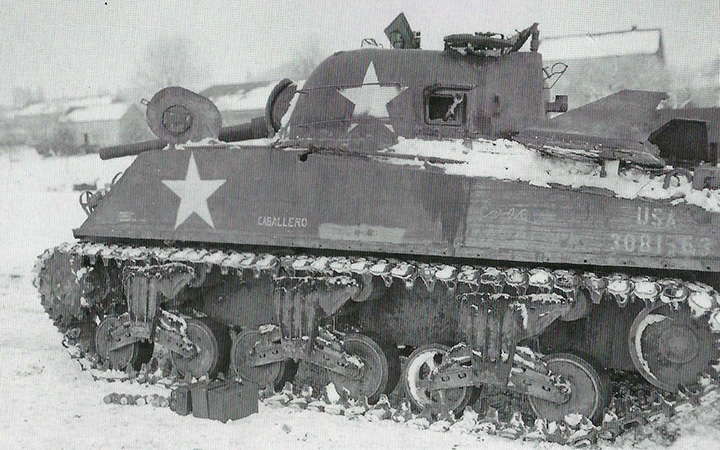
This period photo shows a Fisher Body built
M4A3 tank that was hit
by enemy fire in the Bastogne area during the Battle for the Bulge.
Registration number 3081563 was one of the 339 M4A3 tanks built in March 1944 at the Fisher Tank Arsenal in Grand
Blanc, MI. Between February 1944 and March 1945 Fisher Body
built 3,071 M4A3 Sherman tanks. Photo courtesy of the Patton
Museum.
Grand Blanc was the only location to produce
an up-armored version of the M4A3. It was designated M4A3E2 and was
known as the "Jumbo". Production of the "Jumbo" ran for two months
from May to July 1944 and these were then immediately shipped to the combat zone
in Europe. Of the 43 Fisher Body built M4A3 Sherman tanks still in
existence, seven are M4A3E2s.
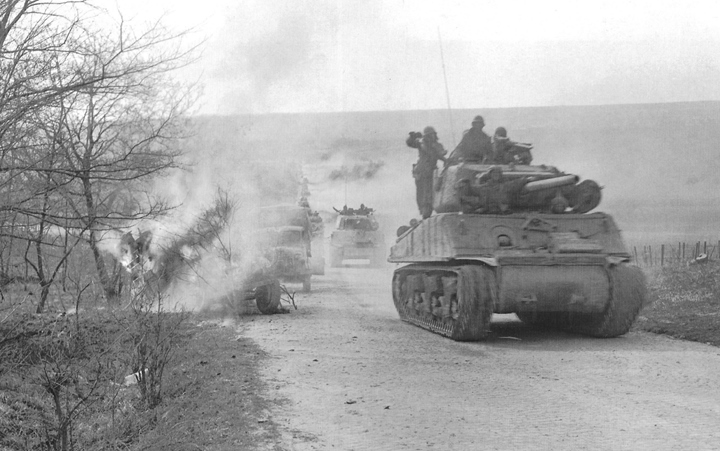
A Fisher Body Grand Blanc, MI M4A3E2
"Jumbo" tank passes burning German vehicles in March 1945.
Components for the Buick assembled M18
Hellcat Tank Destroyer:
Besides building tanks and tank destroyers, Grand Blanc provided 2,445
turrets and 1,511 hulls for the 2,507 M18 Hellcats built by the Buick
Division of GM. It also converted and reconditioned 600 previously
built and used M-18s into M39 prime movers for the US Army.
M39 Prime Movers:
Buick was also
the prime contractor of this vehicle, but Fisher Body Flint #1 and Grand
Blanc did all of the work. Fisher Body converted 600 previously
used M18s
to the M39 Prime Mover. Fisher Plant #1 did the
design changes and built the necessary fixtures. Another 40 brand
new M39s were built by Fisher Body.
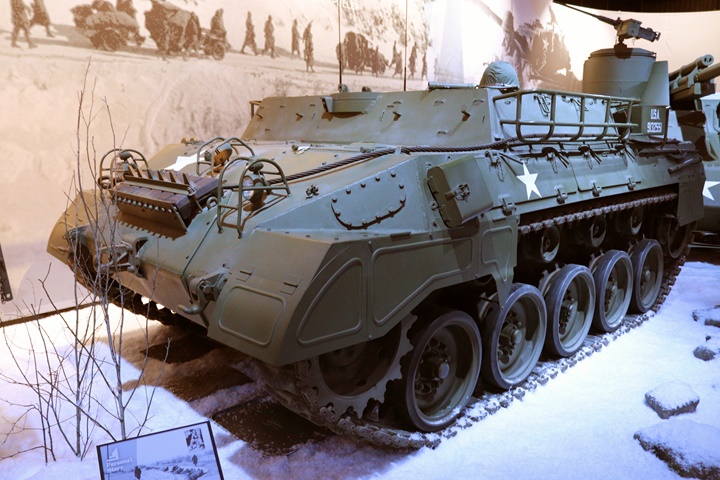
This is one of only twelve M39s that still
exist of the 640 that were originally built or converted from the M18
Hellcat. Mostly likely the 600 conversions were done at Flint #1
to not slow down the production of the M26 Pershing heavy tank at Grand
Blanc. An assembly line could have been set up to remove the
turret and gut the interior. The armored shield that went around
the crew area would need to then be welded on, and the the new interior
installed. The new 40 M39s could have been built in either plant
but most likely this would have been done at Grand Blanc as the hull
needed to be welded. After that they could have been sent to Flint
#1 for the interior install. Author's photo added 11-7-2019.
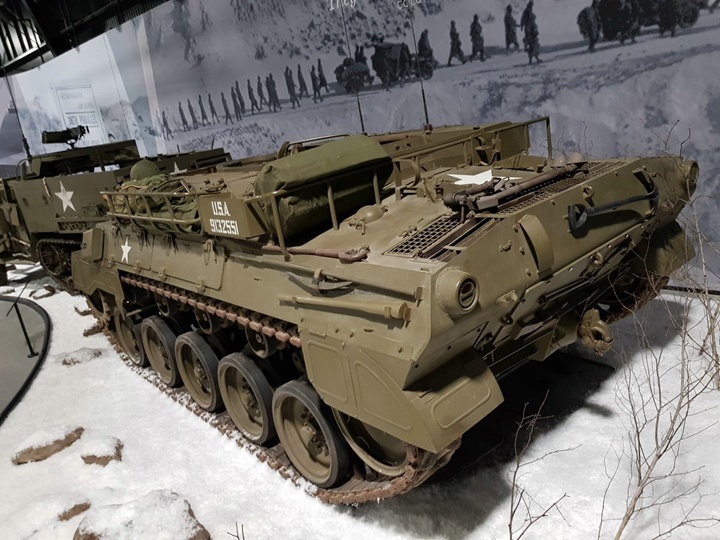
Image courtesy of Pierre-Olivier Baun added 11-7-2019.
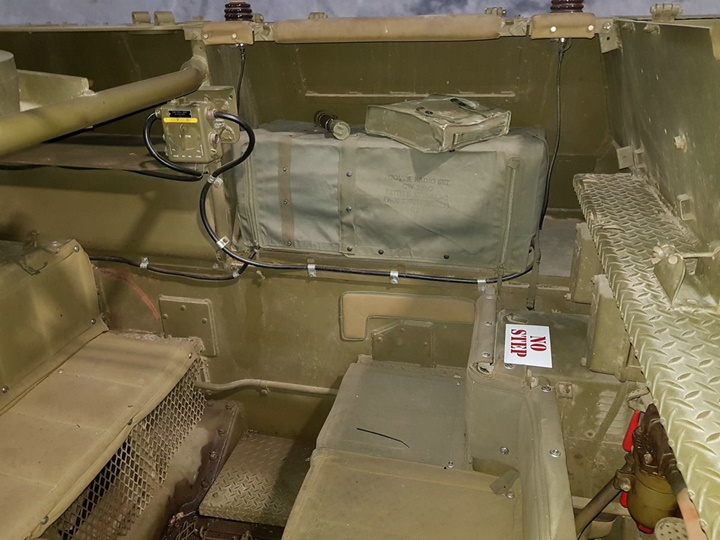
Image courtesy of Pierre-Olivier Baun added 11-7-2019.
T26E3/ M26 Pershing Tanks:
The only T25E3/M26 Pershing heavy tanks that arrived in Europe in time
for combat at the end of WWII were Fisher Body Grand Blanc built
starting in November 1944.
Chrysler did not start producing the M26 until March 1945 which was too
late to get them to the European combat zone before the war ended two
months later.
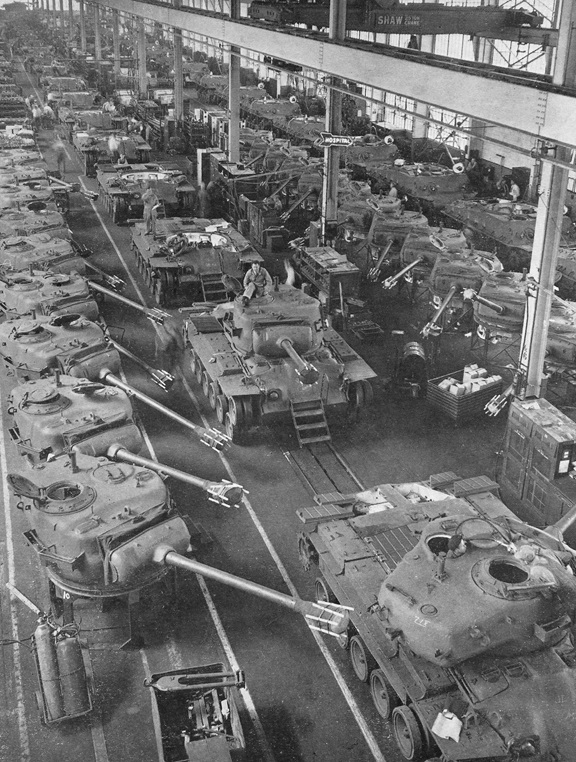
M26 Pershing tanks can be seen coming down
the production line sometime after November 1944 at Grand Blanc.
Photo added 11-20-2-15.
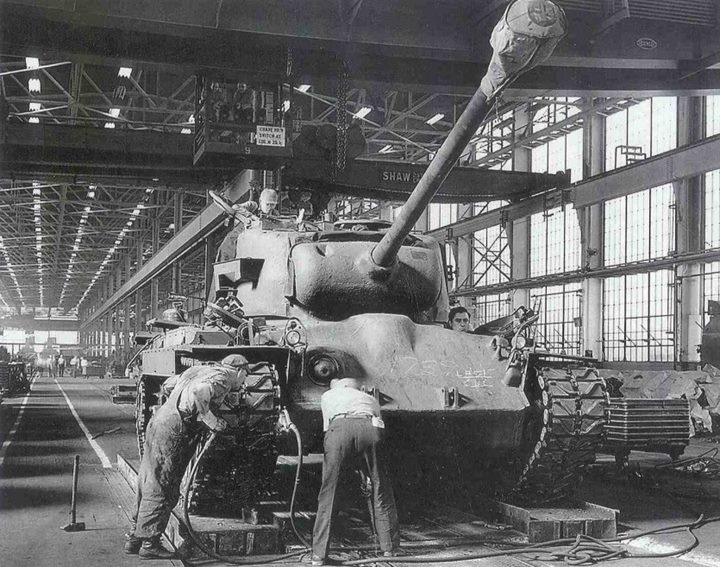
The assembly line is empty in October 1945
as the last Grand Blanc M26 Pershing comes down the line. Photo
added 12-17-2016.
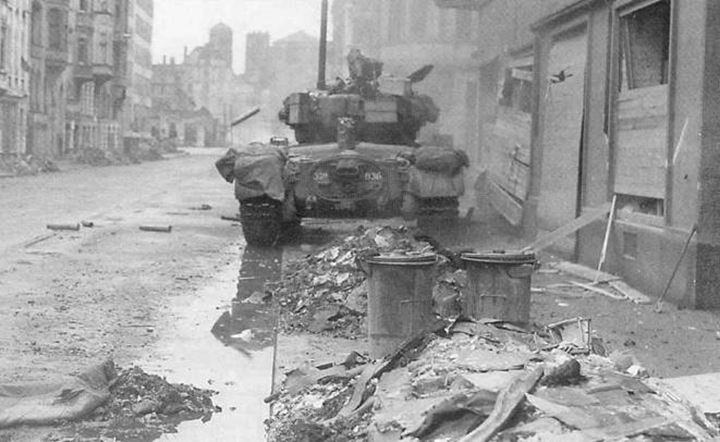
An empty 90mm shell casing is being thrown
out of this Fisher Body built T26E3 on the streets of Cologne, Germany
in March 1945. It is serial number 26. When sent to Europe, the Pershing was still
designated T26E3 as the tank had not yet been officially accepted by the
military. The first twenty T26E3s sent to Europe for
combat evaluation were all Fisher Body built; and of the 310 Grand Blanc
Pershing tanks to arrive before the end of the war, they saw all or most of the combat.
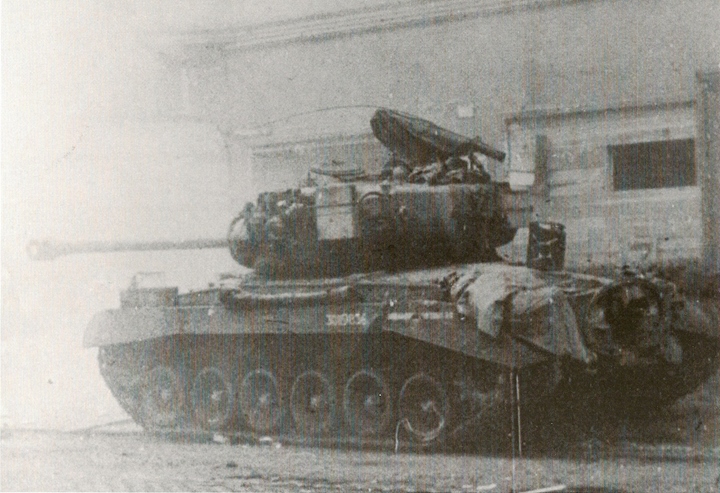
In this photo the same Grand Blanc built M26 is
seen firing its 90 mm main gun in the fire fight. Photo added 11-20-2015.
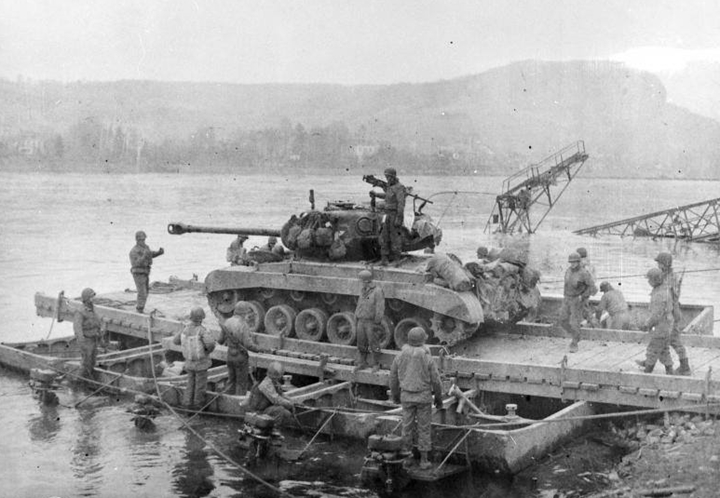
One of the Fisher Body four built T26E3s that were involved in the capture of the Remagen
Bridge is being ferried across the Rhine River. The serial numbers
were 27, 28, 35, and 39. Photo added 11-20-2015.
|
Fisher Body
built T26E3 Pershings in Europe 1945 - The Zebra
Mission |
|
Serial Number |
Registration Number |
Division |
Regiment |
Battalion |
Company |
Comments |
| 22 |
30119832 |
9th Armored |
|
14th Tank BN |
A |
March 1, 1945 hit by two explosive shells during the night.
The first one set fire to the engine compartment and the
crew dismounted to fight the fire. The second round
then struck the rear of the turret and killed Platoon
Sergeant Chester Key. The tank was eventually returned
to service. |
| 23 |
30119833 |
9th Armored |
|
19th Tank BN |
C |
Undocumented. |
| 24 |
30119834 |
3rd Armored |
33rd Armored |
|
D |
Undocumented. |
| 25 |
30119835 |
3rd Armored |
33rd Armored |
|
H |
This Pershing was knocked out by a self propelled 88mm
Nashorn tank destroyer. The 88mm round set the tank on
fire but the crew escaped. Due to the length of time
to repair it was used for spare parts. Of the 20
original Fisher Body T26E3s that were sent to Europe, it was
the only to not end the war on active service. |
| 26 |
30119836 |
3rd Armored |
32nd Armored |
|
E |
This may be the most famous Pershing of all time, as it is
the one that knocked out the Panther in front of the Cologne
Cathedral on March 6, 1945. Photos and video of this
can be found online. Pershing #26 avenged the
loss of an Sherman just a few minutes earlier by the
Panther.
Also see the photos above. |
| 27 |
30119837 |
9th Armored |
|
14th Tank BN |
A |
This Fisher Body Grand Blanc Tank Arsenal T26E3 was one of
four at the Remagen Ludendorf Railway Bridge from March 7,
1945 to March 12, 1945.
On February 28, 1945 this Pershing broke a piston during the
crossing of the Roer River in Germany. It was repaired
and returned to service on March 5. |
| 28 |
30119838 |
9th Armored |
|
14th Tank BN |
A |
This Fisher Body Grand Blanc Tank Arsenal T26E3 was one of
four at the Remagen Ludendorf Railway Bridge from March 7,
1945 to March 12, 1945. |
| 29 |
30119839 |
9th Armored |
|
19th Tank BN |
B |
Undocumented. |
| 30 |
30119840 |
9th Armored |
|
19th Tank BN |
A |
Undocumented. |
| 31 |
30119841 |
3rd Armored |
32nd Armored |
|
H |
Undocumented. |
| 32 |
30119842 |
9th Armored |
|
19th Tank BN |
B |
Undocumented. |
| 33 |
30119843 |
3rd Armored |
32nd Armored |
|
G |
This Pershing knocked out a Panzer IV at Manheim in early
March 1945. |
| 34 |
30119844 |
3rd Armored |
32nd Armored |
|
I |
|
| 35 |
30119845 |
9th Armored |
|
14th Tank BN |
A |
This Fisher Body Grand Blanc Tank Arsenal T26E3 was one of
four at the Remagen Ludendorf Railway Bridge from March 7,
1945 to March 12, 1945.
See my M26 page for more
information about this tank, which may still exist at the
Wright Museum of WWII in Wolfeboro, NH. |
| 36 |
30119846 |
3rd Armored |
32nd Armored |
|
D |
On or about March 6, 1945 this Pershing knocked out a Tiger
I on the Cologne drive. |
| 37 |
30119847 |
3rd Armored |
33rd Armored |
|
I |
This suffered an engine failure and was returned to service
on March 5, 1945. |
| 38 |
30119848 |
3rd Armored |
33rd Armored |
|
F |
This was named "Fireball" by the crew. It was the
first Pershing hit during WWII February 26, 1945. It
was hit by three rounds from Tiger tank at Elsdorf, Germany.
It was guarding a roadblock during the night and the turret
was exposed by a nearby coal fire. The tank was
repaired with a 90mm gun from an M36 tank destroyer and
returned to combat on March 7. |
| 39 |
30119849 |
9th Armored |
|
14th Tank BN |
A |
This Fisher Body Grand Blanc Tank Arsenal T26E3 was one of
four at the Remagen Ludendorf Railway Bridge from March 7,
1945 to March 12, 1945. |
| 40 |
30119850 |
3rd Armored |
33rd Armored |
|
E |
Killed one Tiger 1 and two Panzer IV on February 29, 1945 at
Elsdorf, Germany. This avenged the loss of SN 38
"Fireball" three days earlier. A third Panzee IV was
destroyed by this Pershing enroute to Cologne. |
| 41 |
30119851 |
9th Armored |
|
19th Tank BN |
C |
Undocumented. |
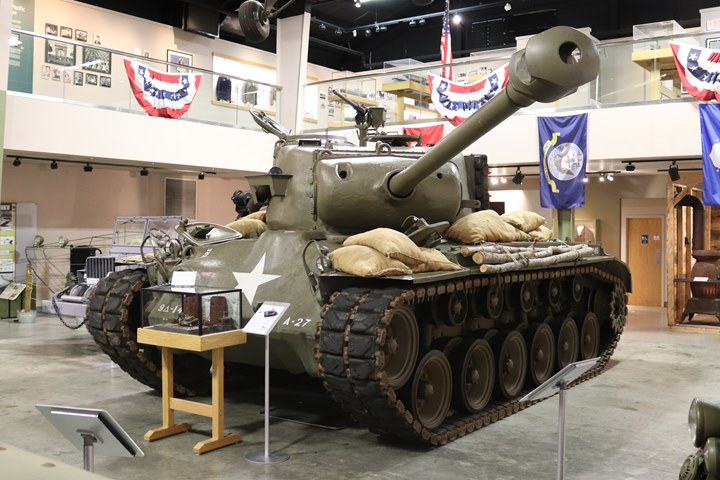
This Fisher Body built Pershing is on display at the Wright Museum of
WWII in Wolfeboro, NH. It may have been one of four Grand Blanc
built T26E3s that helped liberate the Remagen bridge on the Rhine River
on March 7, 1945. See my M26 Photo page for more information and
photos. Author's photo added 8-19-2017.
|
Fisher Body
built M26 Pershings in Okinawa 1945 |
|
Serial Number |
Registration Number |
| 586 |
30127332 |
| 603 |
30127349 |
| 606 |
30127352 |
| 608 |
30127354 |
| 609 |
30127355 |
| 614 |
30127360 |
| 617 |
30127363 |
| 621 |
30127367 |
| 623 |
30127369 |
| 625 |
30127371 |
| 629 |
30127375 |
| 632 |
30127378 |
On June 28, 1945 Army Ordnance announced a
50% cut-back in M26 production; and that the M26 would be produced
until April 1946. With the end of the war, the situation changed
and production was halted at the Chrysler Tank Arsenal on August 27,
1945. Army Ordnance had chosen Grand Blanc to be the sole producer
of the Pershing for the remainder of the war. On October 5, 1945
the Flint Journal reported that Grand Blanc production was still running
at a rate of 200 M26s a month. Five days later it was reported by
the newspaper on October 10, 1945 that production had stopped at the
Grand Blanc Tank Arsenal, and that the 1,500 remaining employees were
being laid off. It was then reported that on January 22, 1946 that
the plant had been returned to the control of the Reconstruction Finance
Corporation.
The Bottom Line: The
significance and impact of the Fisher Body Grand Blanc Tank Arsenal to
the outcome of WWII has never been acknowledged or recognized.
While the Chrysler Tank Plant had considerable publicity, the Grand
Blanc plant's history has remained in the shadows and
generally ignored. While Chrysler had a head start in building tanks, most of
the M3 Lee/Grant tanks it built went to resupply the British tank
inventory after Dunkirk. As this was happening, the Fisher Tank
Arsenal in Grand Blanc was being built.
Grand Blanc started Sherman tank production
two months before Chrysler began its manufacture of the tank. In April 1942 Fisher started building M4A2
tanks, and in June 1942 Chrysler started building the M4A4. The
M4A2 was powered by GM Detroit Diesel engine, and the M4A4 was powered by the
Chrysler A57 Multibank engine. Because neither of these engines
was favored by the US Army, most were sent to either the British or the
Russians under Lend-Lease. For initial Sherman tank production,
tanks from both Arsenals went to foreign nations and did not directly
contributing to the US war effort. But those tanks helped keep our
allies in the war until American forces could arrive on the battlefield.
In September 1942 Grand Blanc started
producing the M10 tank destroyer at the request of the US Army.
There have been many forests felled and gallons of ink used to
debate the usefulness of the American Army's tank and tank destroyer
doctrine during WWII. That is beside the point. At the time, the US
Army wanted and needed fully tracked tank destroyers; and Fisher Body supplied all of
the M10 Wolverines that were used in Europe during WWII. The first
Grand Blanc built M10s to see combat did so with the 899th Tank
Destroyer Battalion in Tunisia in March 1943. As the photos from
above show, the M10 was an important weapon with the US combat teams in
Europe in WWII.
In February 1944 Fisher started producing
the M4A3 Sherman. A month later, Chrysler started producing the
same model. Historians make note that Chrysler took over the M4A3
from Ford, which originally produced the M4A3 tank. This is what is
written in the Chrysler published "TANKS are a Mighty Fine Thing"
history. Later day historians have taken that as gospel without
investigating what really happened. They ignore the fact that
Grand Blanc actually started production a month before Chrysler; and
both produced the M4A3 simultaneously until the end of the war. Both Fisher Body and Chrysler
took over the manufacture of the M4A3 from Ford, with Fisher going into
production first.
In mid-1944, when it became painfully
obvious to the US Army that the 3 inch main gun on the M10 was not
effective against new German tanks being seen on the European
battlefield, it was Fisher Body, not Chrysler, that added turrets with a
90mm main gun to the last 300 Fisher built M10A1 chassis. This was
the M36 Jackson. It was
Grand Blanc that took 187 of its M4A3 chassis off the assembly line, put
a 90mm main gun in a larger turret, and then sent them them to the
battle zone as M36B1's. And it was Fisher Body that supplied the
713 turrets needed to rebuild Ford and Fisher Body manufactured M10A1s into the M36
which was completed by other contractors. Grand Blanc expedited
all of the work on these items in order to get them to the front where
they were needed as soon as possible.
In 1944 in Europe it became evident that the
Sherman tank, even with its new 76mm main gun, was not effective in
penetrating the armor of German tanks, while the armor of the Sherman
could not stand up against enemy anti-tank shells. Again, many trees have been
cut down, and gallons of ink have been spilt on why this was not
recognized as a problem earlier.
There are numerous documented instances of internal US Army
mismanagement, internal bickering, and lack of vision. When the
Army finally decided what it wanted in the T26E3/M26 Pershing Heavy
Tank, Fisher Body Grand Blanc started manufacturing the
weapon four months before Chrysler. All of the Pershing tanks that
saw combat
in Europe were built by Fisher. All Pershings that arrived in
Europe by the end of the war were Grand Blanc built! All of the
M26 Pershings that went to Okinawa were built by Fisher Body. At the end of
the August 1945 Army Ordnance chose the Fisher Tank Arsenal as the only
supplier of the M26. Fisher Body Grand Blanc built 1,729 of the
2,202 Pershings, or 79%.
In conclusion, the Fisher Body Grand Blanc
Tank Arsenal has been over looked in its importance and the timeliness
of its weapons production, as needed by American soldiers. While it did
not produce the largest amount of tanks during WWII, it did produce the
M10s, M4A3s, M36s, M36B1s, and T26E3/M26s when needed to arm the US tank and tank
destroyer battalions with the proper weapons desperately needed on
the European battlefield.
That is its worthy and lasting legacy!
David D Jackson
10-18-2015 with additional comments on 10-24-2017.
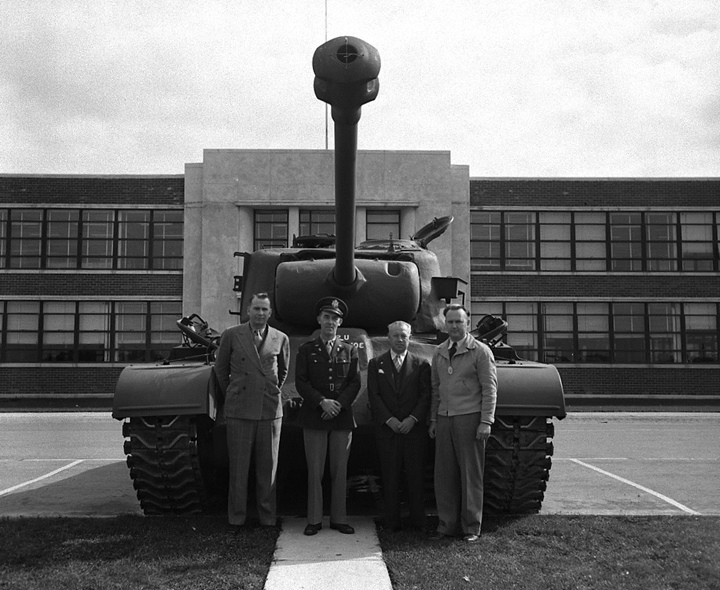
The end of the line! This M26 Pershing
is the last tank to come off the assembly line at Fisher Body Grand
Blanc in October 1945. Photo courtesy of
Genesee County Historical Society via Jeremy Whitman. Photo added
11-20-2-15.
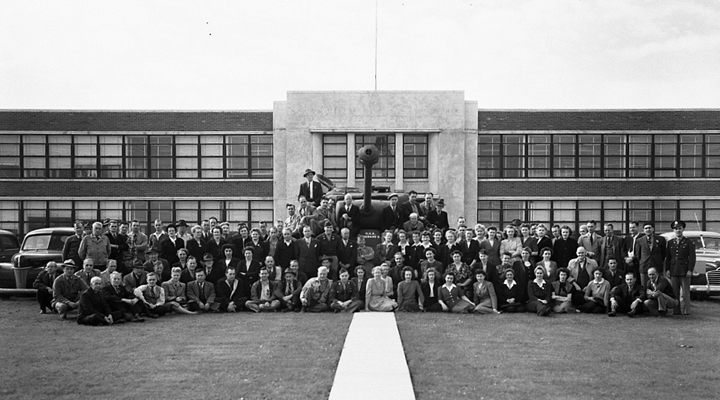
Photo courtesy of Genesee County Historical
Society via Jeremy Whitman. Photo added 11-20-2-15.
World War Two / WWII Products: Below
is a summary of tank and tank destroyer production at Grand Blanc and
below that contemporary photos of the weapons today.
|
Fisher Body
Grand Blanc Tank, Tank Destroyer, and Prime Mover
Production during World War Two |
| Type |
Number built |
Dates |
Engines |
Comments |
| M4A2(75) |
4,325 |
4-1942 to 2-1944 |
Twin 6046 Detroit
Diesel |
Dry Storage for
main gun ammunition. Small hatches for driver and assistant
driver. |
| M4A2(75) |
289 |
2-1944 to 5-1944 |
Twin 6046 Detroit
Diesel |
Dry Storage for
main gun ammunition. Large hatches for driver and assistant
driver. |
| M4A3(75) |
3,071 |
2-1944 to 3-1945 |
Ford GAA V8
gasoline, 450–500 hp |
Wet storage for
main gun ammunition. Large hatches for driver and assistant
driver. 539 or 652 of these were HVSS suspensions. |
| M4A3(76) |
525 |
9-1944 to 12-1944 |
Ford GAA V8
gasoline, 450–500 hp |
Wet storage,
large hatch. |
| M4A3E2(75) |
254 |
5-1944 to 7-1944 |
Ford GAA V8
gasoline, 450–500 hp |
Wet storage,
large hatch. This was known as the Jumbo due to the extra
think armor plate. |
| M4A2(76) |
2,894 |
5-1944 to 5-1945 |
Twin 6046 Detroit
diesel |
Wet storage, Large hatch |
| Total M4
Series Tanks |
11,358 |
|
|
This was 23% of
all of the M4 Sherman tanks produced during the war. |
| |
|
|
|
|
|
T20 |
1 |
5-1943 |
|
Registration
number 30103302 |
|
T20E3 |
1 |
|
|
Registration
number 30104303 |
|
Total T20
Series |
2 |
|
|
|
| |
|
|
|
|
|
Total T25E1 |
40 |
2-1944 to 5-1944 |
Ford GAN V8
gasoline, 450-
500 hp |
|
| |
|
|
|
|
| Total T26E1 |
10 |
2-1944 to 5-1944 |
Ford GAF V8
gasoline, 450–500 hp |
Tested
extensively at Aberdeen Proving Grounds. |
| |
|
|
|
|
| Total T26E3/M26 |
1,729 |
11-1944 to 10-1945 |
Ford GAF V8
gasoline, 450–500 hp |
90mm main gun.
The first twenty T26E3s to be sent to Europe in early 1945 were
Fisher Body built. They saw most of the combat of the 300
eventually sent to that theatre, as Chrysler did not start
production until March 1945.
The T26E3 tank was renamed the M26
Pershing on March 8,1945. |
| Total Fisher
Body Tanks built during World War Two |
13,139 |
|
|
|
| |
|
|
|
|
| M10 Tank
Destroyer |
4,993 |
9-1942 to 12-1943 |
Twin 6046 Detroit
diesel |
3 inch main gun
on a M4 Sherman hull. This figured differs from the
number most often seen in the literature, which is 4,993.
But the 5,368 figure comes from Fisher Body Craftsmanship
goes to War , a primary source from the manufacturer.
|
| M10A1 Tank
Destroyer |
375 |
10-1943 to 11-1943 |
Ford GAA V8
gasoline, 450–500 hp |
|
| M36 Tank
Destroyers |
300 |
11-43 to 7-44 |
Ford GAA V8
gasoline, 450–500 hp |
These were the
last 300 M10A1s
that came off the Grand Blanc assembly line without turrets.
Fisher then installed the M36 turret with a 90mm main gun. |
| M36B1 Series Tank
Destroyers |
187 |
10-1944 to
12-1944 |
Ford GAA V8
gasoline, 450–500 hp |
These were Fisher
Body built M4A3 Sherman tank hulls that had the M36 turret
installed with a 90mm main gun. This was done to expedite
the delivery of the much need weapon to the battle front in
Europe. |
| Total Fisher
Body Tank Destroyers built during World War Two |
5,855 |
|
|
|
| |
|
|
|
|
|
Total
M39 Prime Movers |
40 |
3-1945 to 3-1945. |
R-975 Nine
Cylinder 420 hp Radial Tank Engine |
This was based on the Buick M18
Hellcat chassis. |
| |
|
|
|
|
|
Total Fisher
Body Tanks, Tank Destroyers, and Prime Movers built during World
War Two |
19,034 |
4-1942 to 10-1945. |
|
|
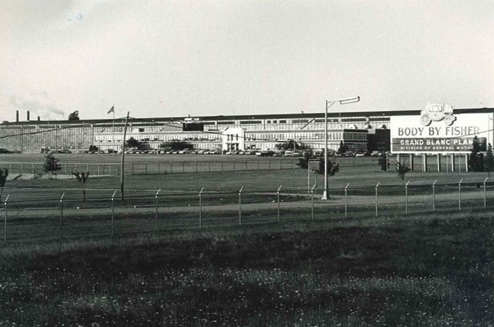
This 1982 photo of the Grand Blanc plant. Note the Body By Fisher
sign with the iconic Coach on it.
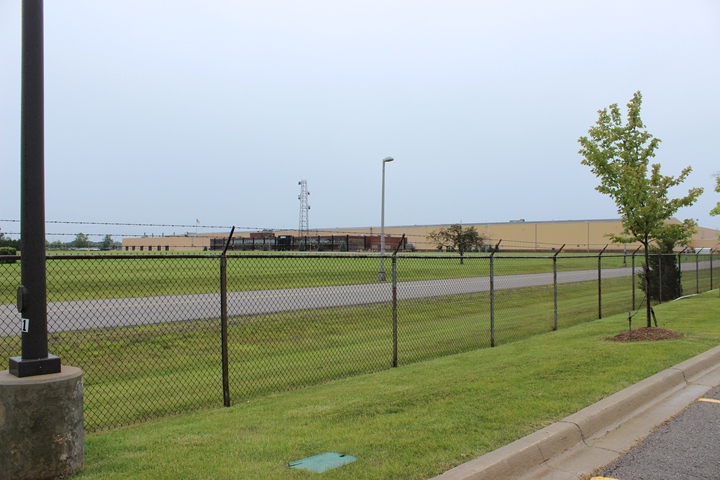
This is a June 2015 photo taken from approximately the same location as the
previous 1982 shot. The Fisher Body sign is gone as the Division
was dissolved in 1986. The plant windows have been covered over
and the administration building has new windows. Author's photo
taken June 2015.
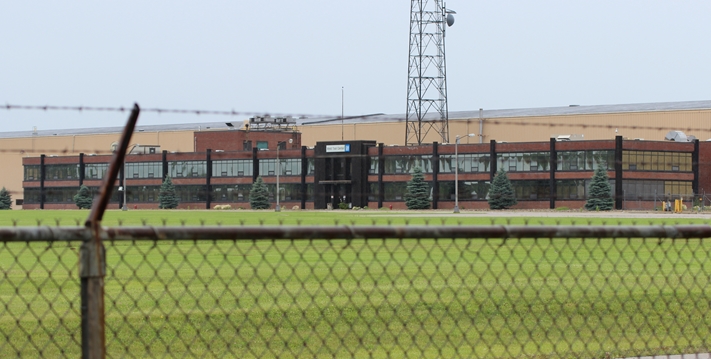
A closer look at the Administration building. Author's photo taken
June 2015.
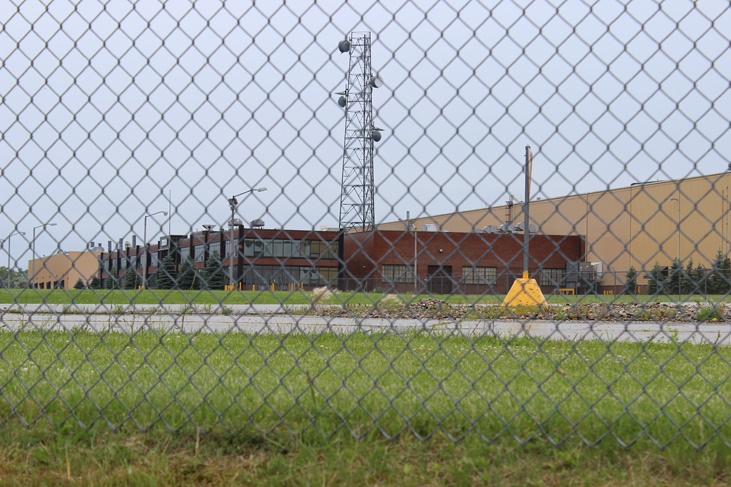
Another photo of the office building and the front of the plant.
Author's photo taken June 2015.
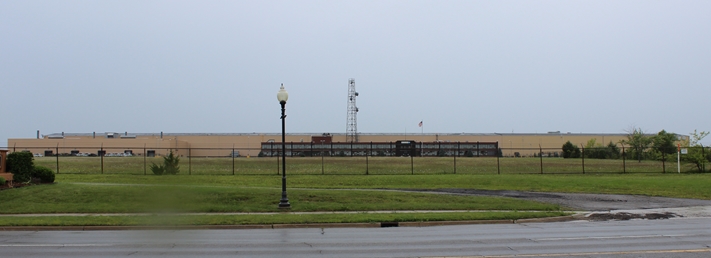
Looking west from across the street on Saginaw Street.
Author's photo taken June 2015.
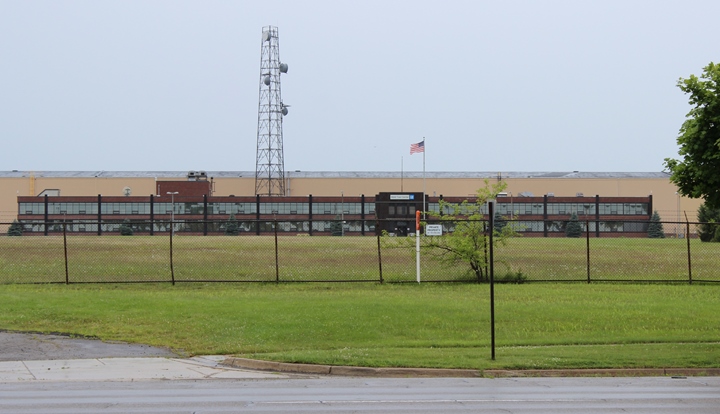
Author's photo taken June 2015.
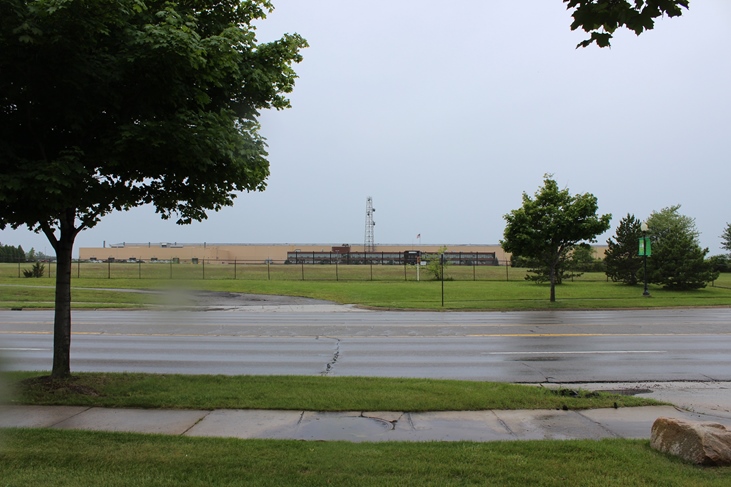
Author's photo taken June 2015.
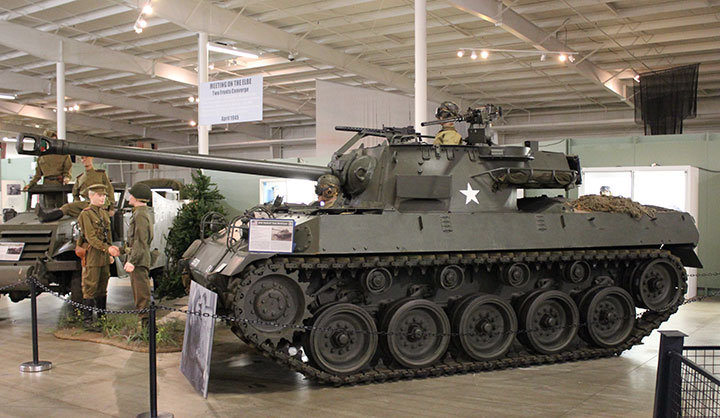
The Grand Blanc Arsenal provided 98% of the
hulls and 60% of the turrets for the Buick assembled M18 tank destroyer.
Author's photo from the National Military Historical Center in Auburn,
IN added 12-4-2015.
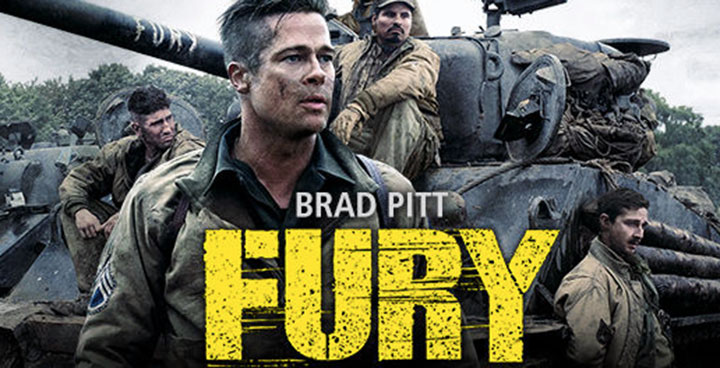
The 2014 movie Fury with Brad Pitt featured a Fisher Body built M4A2E8
Sherman Tank as the other co-star.
In the movie it was supposed to be an M4A3E*
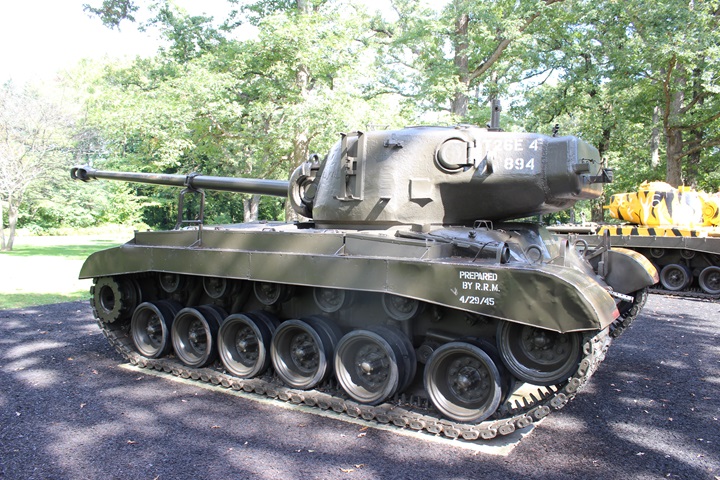
Fisher Body Grand Blanc provided twenty-five
T26E3/M26 chassis only to Wellman Engineering which then added the
turret and long barreled 90mm manin gun. It was designated T26E4s
and was known in the vernacular as a "Super Pershing. This one on display at the First Division
Museum at Cantigny is the only example still in existence. The feature that gave the T26E4 its name
"Super Pershing" is a high velocity T15E2 90mm
cannon that used two part ammunition. Note the large counterweight
welded to the rear of the turret to balance the long gun barrel.
Author's photo added 9-30-2015.
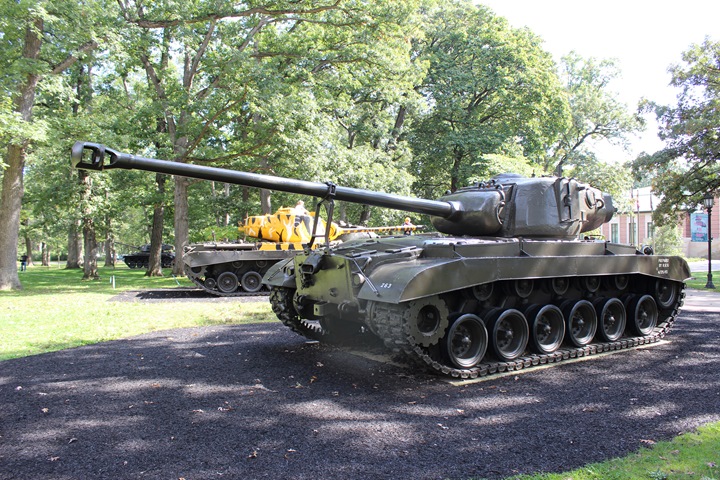
This photo shows the long barrel of the
T15E2 90mm cannon, which was five and a half feet longer than the normal
M3 90mm cannon on the T26E3/M26s. An
M46 Patton tank can be seen in the background, and was the next version
of the M26 with a more powerful 830 hp engine. It is one of the many
fine tanks on display outside at in the First Division Museum's tank
park. Author's photo added 9-30-2015.
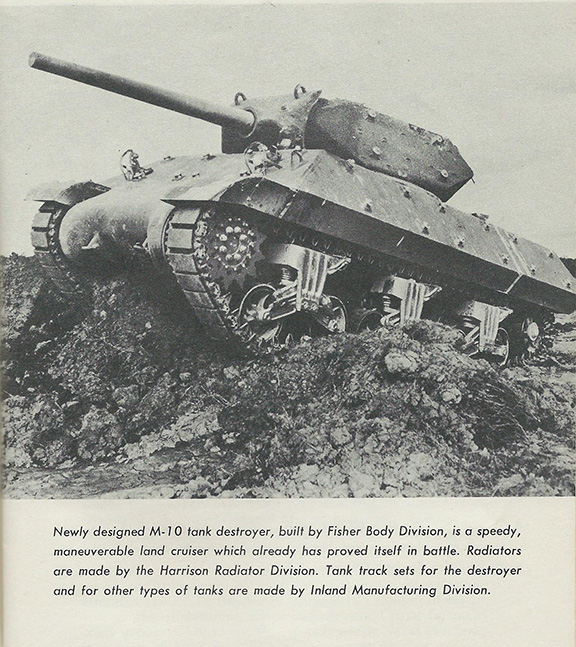
This page from the 1942 GM Annual Report
states Fisher Body built the M10, while other GM Divisions supplied
components for the tank destroyer.
Post WWII: Between 1952 and 1955
Fisher Body and the Grand Blanc Tank Arsenal again answered its
country's call and produced 4,200 M48 and M48A1 Patton tanks.
Originally produced by Fisher Body, Ford, and Chrysler, the M48 was only
built by Fisher Body after 1953.
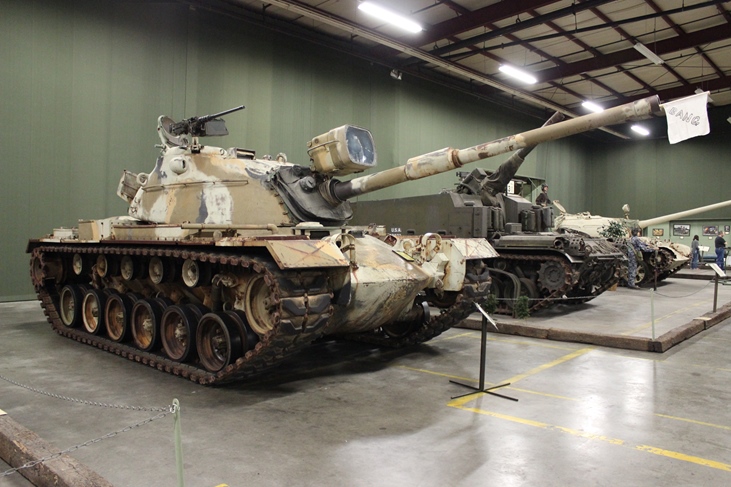
This M48A5 on display at the AAF Tank Museum
in Danville, VA started life as Grand Blanc built M48A1 with a 90mm main
gun. It was one of 2,069 M48A1s converted to the A5
version that had a M60 turret with a 105mm main gun. Author's
photo added 12-4-2015.
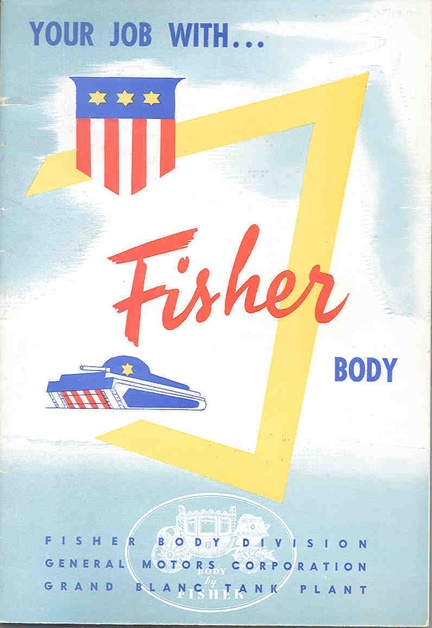
Photo added 12-16-2016.
|



















































